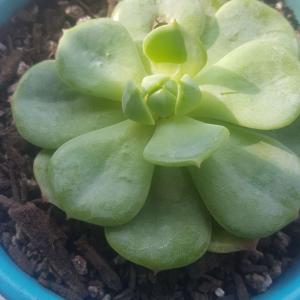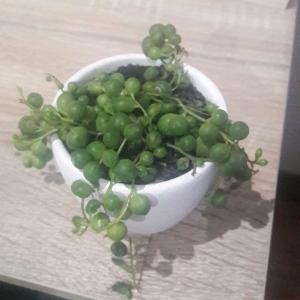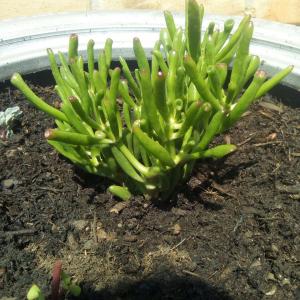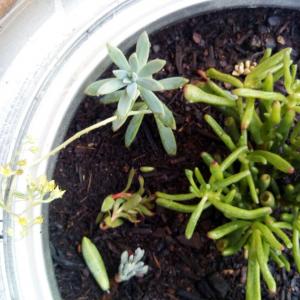成长记
Succulentlover72
2017年09月24日

I new added a "Propagate from leaves" in my "garden"
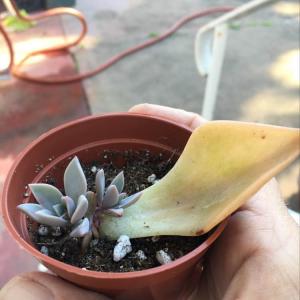

3
0
meriunkat:💜💚
文章
Dummer. ゛☀
2017年09月24日

GARDEN designers know that when it comes to annuals, it's not just about the flowers — foliage matters, too. And when it comes to foliage, coleus tops the list. Though it has fallen in and out of favor over the past couple of centuries, this member of the mint family is popular again, and the selection is better than ever.
When breeders try to create new plants, the focus is often on new color combinations. In recent years, other considerations have become prominent, too:

sun-tolerance
delayed flowering
more prolific branching
special growth habits, such as compact and trailing
How to Choose
The variability in patterns is amazing, with solid colors, splashes, blotches, streaks, flecks, margins and veins. Color intensity varies, depending on sunlight, heat sensitivity and other conditions. The term "sun coleus" refers to selections that tolerate more sun. The varieties with dark leaves tend to tolerate more sun, while lighter varieties need more shade to minimize leaf scorch. Morning sun and dappled afternoon shade tends to maintain consistent foliage coloration. Too little light will encourage a weak-stemmed, less vigorous plant without the best color.
Another variable to consider is leaf texture, which includes large, small, twisted, elongated, scalloped, lobed, finger-like, and "duck's foot" — they resemble webbed feet.
Coleus can be grouped into three plant forms: upright, rounded and trailing. Frequent snipping, pinching and trimming can help modify form although the trailing varieties have great value at the edge of a planter or in a hanging basket.

Planting and Care
Coleus has long been considered a shade plant but the best leaf color is achieved with morning sun and some degree of afternoon shade. Many varieties do well in both shade and part-sun. Some can take quite a bit of sun as long as they are not allowed to dry out. Avoid overly damp soils, which can cause leaf drop and encourage disease. Plant coleus after danger of frost has passed when soil temperatures have warmed sufficiently and evening temperatures are above 60 degrees F. Feed plants regularly with a water-soluble fertilizer, especially if they are growing in containers.
To maintain plant form, pinch back every few weeks to prevent flower formation. Pinch just above a set of leaves or branching junction for the best appearance; don't leave a stub. Some gardeners leave the small flowers, but it's best to pinch them off to direct more energy into stem and foliage growth. Coleus left to flower may lose vigor as the plant puts energy into seed production.

Getting More Plants
Raising coleus from seed is relatively easy. Plan to sow them indoors, eight to 12 weeks before the last frost date in your area. Because seeds require light to germinate, sow them on the surface. Be sure to monitor water levels carefully. For best results, use a seedstarting system and read How to Start Seeds.
Overwintering coleus plants as houseplants is another way to get more plants. Temperatures near 70 degrees F. are required. Rotate plants and pinch back as needed to maintain form. Use grow lights to provide adequate light.
Designing With Coleus
Use solid-color coleus varieties, such as Redhead and Lime Delight Premium Sun (both bred for the sun), to make a bold statement in the garden. Try multicolored varieites for "color echoes" that complement neighboring plants that have similar (or contrasting) flower and/or foliage colors. The repetition of certain coleus colors and form can lend unity and harmony in the garden. While a solitary specimen can add a "punch" of color, consider the impact of mass planting as well. Foliage with lighter colors can illuminate shady locations while dark colors in the same setting will create depth and contrast.
Coleus in Containers
Coleus do well in pots and planters, as long as they are planted in free-draining potting soil, fertilized regularly and given the right amount of sun. Avoid windy locations because coleus can be prone to breakage. Feed regularly during the growing season, following the rate recommended on the package. Coleus do not show their best color if over-fertilized, so be conservative and consistent. You may want to consider self-watering planters, especially in sunny locations.
Coleus can be included in hanging baskets, too. Some of the trailing selections will flow nicely over the edge. Compact, bushy types can be used in the center of the basket. Keep in mind that coleus are thirsty and a hanging basket can dry out quickly — choose a self-watering basket for best results.
When breeders try to create new plants, the focus is often on new color combinations. In recent years, other considerations have become prominent, too:

sun-tolerance
delayed flowering
more prolific branching
special growth habits, such as compact and trailing
How to Choose
The variability in patterns is amazing, with solid colors, splashes, blotches, streaks, flecks, margins and veins. Color intensity varies, depending on sunlight, heat sensitivity and other conditions. The term "sun coleus" refers to selections that tolerate more sun. The varieties with dark leaves tend to tolerate more sun, while lighter varieties need more shade to minimize leaf scorch. Morning sun and dappled afternoon shade tends to maintain consistent foliage coloration. Too little light will encourage a weak-stemmed, less vigorous plant without the best color.
Another variable to consider is leaf texture, which includes large, small, twisted, elongated, scalloped, lobed, finger-like, and "duck's foot" — they resemble webbed feet.
Coleus can be grouped into three plant forms: upright, rounded and trailing. Frequent snipping, pinching and trimming can help modify form although the trailing varieties have great value at the edge of a planter or in a hanging basket.

Planting and Care
Coleus has long been considered a shade plant but the best leaf color is achieved with morning sun and some degree of afternoon shade. Many varieties do well in both shade and part-sun. Some can take quite a bit of sun as long as they are not allowed to dry out. Avoid overly damp soils, which can cause leaf drop and encourage disease. Plant coleus after danger of frost has passed when soil temperatures have warmed sufficiently and evening temperatures are above 60 degrees F. Feed plants regularly with a water-soluble fertilizer, especially if they are growing in containers.
To maintain plant form, pinch back every few weeks to prevent flower formation. Pinch just above a set of leaves or branching junction for the best appearance; don't leave a stub. Some gardeners leave the small flowers, but it's best to pinch them off to direct more energy into stem and foliage growth. Coleus left to flower may lose vigor as the plant puts energy into seed production.

Getting More Plants
Raising coleus from seed is relatively easy. Plan to sow them indoors, eight to 12 weeks before the last frost date in your area. Because seeds require light to germinate, sow them on the surface. Be sure to monitor water levels carefully. For best results, use a seedstarting system and read How to Start Seeds.
Overwintering coleus plants as houseplants is another way to get more plants. Temperatures near 70 degrees F. are required. Rotate plants and pinch back as needed to maintain form. Use grow lights to provide adequate light.
Designing With Coleus
Use solid-color coleus varieties, such as Redhead and Lime Delight Premium Sun (both bred for the sun), to make a bold statement in the garden. Try multicolored varieites for "color echoes" that complement neighboring plants that have similar (or contrasting) flower and/or foliage colors. The repetition of certain coleus colors and form can lend unity and harmony in the garden. While a solitary specimen can add a "punch" of color, consider the impact of mass planting as well. Foliage with lighter colors can illuminate shady locations while dark colors in the same setting will create depth and contrast.
Coleus in Containers
Coleus do well in pots and planters, as long as they are planted in free-draining potting soil, fertilized regularly and given the right amount of sun. Avoid windy locations because coleus can be prone to breakage. Feed regularly during the growing season, following the rate recommended on the package. Coleus do not show their best color if over-fertilized, so be conservative and consistent. You may want to consider self-watering planters, especially in sunny locations.
Coleus can be included in hanging baskets, too. Some of the trailing selections will flow nicely over the edge. Compact, bushy types can be used in the center of the basket. Keep in mind that coleus are thirsty and a hanging basket can dry out quickly — choose a self-watering basket for best results.
0
0
文章
Dummer. ゛☀
2017年09月24日

EVERY flower gardener should know the pleasure of growing clematis. If you already have one in your garden, you're probably scheming about how to squeeze in another! New to clematis? Read on and discover how easy it is to be successful with the "queen of climbers."

Selecting a Plant
Until fairly recently, only a handful of clematis cultivars were readily available in the U.S. Some of these traditional favorites include Jackmanii, General Sikorski, Henryi and Comtesse de Bouchard. But clematis have become a hugely popular perennial, and today, the average local garden center offers dozens of different choices.
When selecting a clematis for your garden, you'll want to think about a couple things, which include its mature height, flower form and color.
If you have room for a vigorous 10- or 20-foot clematis vine, there are many wonderful cultivars that will fit the bill. There are also more compact varieties that are perfectly happy growing in a small garden or even in a pot on the patio.
The standard clematis flower form is a large blossom with six or seven petals, measuring 5-6" across. There are also cultivars with smaller blossoms, double blossoms, and lovely bell-like flowers. Colors range from white to wine red, lavender to deep purple, and there are even a few yellow ones.
It can take several years for a clematis vine to mature and begin flowering vigorously. To shorten the wait and help ensure your success, it's best to purchase a plant that's at least two years old. Look for a container-grown plant in a quart or gallon-size pot. If you're shopping for your clematis at a garden center or nursery, select a robust plant that's showing vigorous growth, rather than a weak plant with a beautiful picture.

Where to Plant It
Hopefully you have a planting location in mind before you bring home your new clematis. Ideally it's a sunny spot. Though some clematis cultivars will bloom in partial shade (such as Nellie Moser and Henryii), to reach their full potential they need at least six hours of sun each day.
Clematis prefer moist, well-drained soil that's neutral to slightly alkaline in pH. If your soil tends to be acidic, you should sweeten it periodically with limestone or a little wood ash. Dig a good hole for your new clematis, working in lots of compost and some granular organic fertilizer.
Be very gentle when settling the plant into its new home; the roots, crown and emerging vines of clematis can be easily broken. Position the plant slightly deeper than it was growing in the pot, so the first set of true leaves is just under the soil surface. Water weekly for the first season, to help the plant get established. If you can get your clematis through its first year, chances are good that it will continue to thrive. Mulching around the base of the plant will help conserve moisture, but keep the mulch several inches away from the crown, where the vines emerge from the soil.
Clematis are happiest with cool shade at their roots and warm sun on their foliage. Mulching around the roots will help keep the soil cool, as will the foliage of a low-growing perennial.

How to Support It
Though there are some types of clematis that have a bushy habit, most of them are born to climb. Like other climbing plants, the growing end of a clematis vine is searching for something to grab onto, and if it can't find anything, it will stop growing. Make sure you provide it with something to climb on from day one.
A clematis vine does not climb by twining around something, as a pole bean or a morning glory does. It climbs by wrapping its leaf stems around something. Because these leaf stems are not very long, anything that's more than about 1/2 inch in diameter is too wide for the leaf stem to twist around. The easiest things for a clematis to grab onto, are twine, fishing line, wire, thin branches, wooden dowels or steel rods. The more grabbing opportunities you offer, the better, so even if you have a nice trellis, consider adding some twine "helper" lines, or covering your trellis with a grid of trellis netting.
Depending on the vigor of the plant and the type of trellis you have, you'll probably need to do some "trussing" during the season to help support the vines and keep them attached to the trellis. Both fishing line and twine work well for this job.

Pruning and Care
Clematis vary in their need for pruning. Some types flower on last year's vines, so you want to avoid cutting them to the ground in the spring. Others flower on current-year vines, so they don't mind being cut to the ground each year. Rather than driving yourself crazy trying to keep track of the ideal pruning technique for each cultivar, try this common-sense approach: leave the prior year's growth in place until mid-spring. Begin pruning only when you can see which vines are dead and which ones are starting to leaf out.
A happy clematis plant puts out an amazing amount of flowers and foliage. Feed your plants well to keep them healthy and vigorous. In early spring, surround the plant with a shovelful of compost and a handful of granular organic fertilizer. Feed again, once or twice during the growing season, with a water-soluble organic fertilizer.

Selecting a Plant
Until fairly recently, only a handful of clematis cultivars were readily available in the U.S. Some of these traditional favorites include Jackmanii, General Sikorski, Henryi and Comtesse de Bouchard. But clematis have become a hugely popular perennial, and today, the average local garden center offers dozens of different choices.
When selecting a clematis for your garden, you'll want to think about a couple things, which include its mature height, flower form and color.
If you have room for a vigorous 10- or 20-foot clematis vine, there are many wonderful cultivars that will fit the bill. There are also more compact varieties that are perfectly happy growing in a small garden or even in a pot on the patio.
The standard clematis flower form is a large blossom with six or seven petals, measuring 5-6" across. There are also cultivars with smaller blossoms, double blossoms, and lovely bell-like flowers. Colors range from white to wine red, lavender to deep purple, and there are even a few yellow ones.
It can take several years for a clematis vine to mature and begin flowering vigorously. To shorten the wait and help ensure your success, it's best to purchase a plant that's at least two years old. Look for a container-grown plant in a quart or gallon-size pot. If you're shopping for your clematis at a garden center or nursery, select a robust plant that's showing vigorous growth, rather than a weak plant with a beautiful picture.

Where to Plant It
Hopefully you have a planting location in mind before you bring home your new clematis. Ideally it's a sunny spot. Though some clematis cultivars will bloom in partial shade (such as Nellie Moser and Henryii), to reach their full potential they need at least six hours of sun each day.
Clematis prefer moist, well-drained soil that's neutral to slightly alkaline in pH. If your soil tends to be acidic, you should sweeten it periodically with limestone or a little wood ash. Dig a good hole for your new clematis, working in lots of compost and some granular organic fertilizer.
Be very gentle when settling the plant into its new home; the roots, crown and emerging vines of clematis can be easily broken. Position the plant slightly deeper than it was growing in the pot, so the first set of true leaves is just under the soil surface. Water weekly for the first season, to help the plant get established. If you can get your clematis through its first year, chances are good that it will continue to thrive. Mulching around the base of the plant will help conserve moisture, but keep the mulch several inches away from the crown, where the vines emerge from the soil.
Clematis are happiest with cool shade at their roots and warm sun on their foliage. Mulching around the roots will help keep the soil cool, as will the foliage of a low-growing perennial.

How to Support It
Though there are some types of clematis that have a bushy habit, most of them are born to climb. Like other climbing plants, the growing end of a clematis vine is searching for something to grab onto, and if it can't find anything, it will stop growing. Make sure you provide it with something to climb on from day one.
A clematis vine does not climb by twining around something, as a pole bean or a morning glory does. It climbs by wrapping its leaf stems around something. Because these leaf stems are not very long, anything that's more than about 1/2 inch in diameter is too wide for the leaf stem to twist around. The easiest things for a clematis to grab onto, are twine, fishing line, wire, thin branches, wooden dowels or steel rods. The more grabbing opportunities you offer, the better, so even if you have a nice trellis, consider adding some twine "helper" lines, or covering your trellis with a grid of trellis netting.
Depending on the vigor of the plant and the type of trellis you have, you'll probably need to do some "trussing" during the season to help support the vines and keep them attached to the trellis. Both fishing line and twine work well for this job.

Pruning and Care
Clematis vary in their need for pruning. Some types flower on last year's vines, so you want to avoid cutting them to the ground in the spring. Others flower on current-year vines, so they don't mind being cut to the ground each year. Rather than driving yourself crazy trying to keep track of the ideal pruning technique for each cultivar, try this common-sense approach: leave the prior year's growth in place until mid-spring. Begin pruning only when you can see which vines are dead and which ones are starting to leaf out.
A happy clematis plant puts out an amazing amount of flowers and foliage. Feed your plants well to keep them healthy and vigorous. In early spring, surround the plant with a shovelful of compost and a handful of granular organic fertilizer. Feed again, once or twice during the growing season, with a water-soluble organic fertilizer.
0
0
文章
Dummer. ゛☀
2017年09月24日

ONIONS, shallots and garlic are members of the allium family that belong in the vegetable garden. But there are many ornamental alliums that deserve a hearty welcome in your perennial gardens.
Alliums are plants of exquisite beauty in both flower and leaf, with tough constitutions. These easy-to-grow bulbs come in a broad palette of colors, heights, bloom times and flower forms. They make excellent cut flowers for fresh or dried bouquets. Even crowded gardens can accommodate a few alliums because they don't take up much space. What's more, alliums are relatively resistant to deer, voles, chipmunks, and rabbits

Ordinary Onions They're Not
There are more than 700 different types of alliums in the world. It wasn't until the late 1800s that this vast group of plants started to intrigue plant lovers. Russian botanists began collecting some of the spectacular alliums from Central Asia and introducing them to avid horticulturists through the Imperial Botanical Garden in St. Petersburg. Of course, it didn't take long for the consummate plant hunters, the British, to get wind of this "new" family of garden-worthy plants. Their expeditions yielded many more interesting alliums varieties.
Hardy, Easy-Care, Deer- and Rodent-Resistant
Ornamental alliums are hardy to zone 4 and they have very undemanding cultural requirements. They will grow in most any soil, as long as it is well-drained. Alliums adore sunlight and will perform best when they can bask in it all day long. Since most of them multiply naturally, they can be left untouched in the same area for years.
Alliums are drought-tolerant plants that actually prefer to be grown on the dry side. There are no serious diseases or insect pests that bother them. And you won't ever have to worry about rodents or deer, since they seem to have no appreciation for the taste of onions — ornamental or otherwise.
Just remember, there's only one time of year you can plant alliums: in the fall. Daffodils, tulips and crocuses are easy to find at most garden centers, but alliums are not as readily available. To make sure you have the bulbs in hand when it's time to plant, the best thing to do is order them by mail. That way, they'll show up at your door at proper planting time, and there's no chance you'll have to live another year without these beautiful, long-lasting, bee-friendly flowers in your garden. Some ornamental alliums grow more like chives and what you plant is a clump of roots rather than bulbs. This type of allium is usually sold as a potted plant, and may be more available in spring than fall.

Favorite Alliums
There are dozens of varieties in cultivation; here are some of the best.
Purple Sensation: the 2″ to 4″ diameter purple globes bloom in early June, right after the late tulips. Purple Sensation's sturdy stems rise 24″ to 30″ high, so the flowers appear to float above the foliage of newly emerging perennials./p>
Globemaster and Gladiator: The tallest and most architectural alliums have huge, globe-shaped flowerheads on 3- to 4-foot stems. Bloom time is early to mid-June. A group of deep-purple Globemaster or Gladiator alliums is a real eye-catcher, especially when planted with white or pink peonies, delphiniums or tall bearded iris. The white-flowering Mount Everest is a bit shorter and looks sharp in front of shrubs with deep-green or burgundy foliage or rising out of a groundcover of periwinkle (Vinca minor).
Corkscrew allium: Drought-tolerant corkscrew allium (Allium senescens ssp. montanum var. glaucum) makes a good edging plant in the dry soil at the top of my stone retaining wall. Its blue-green leaves twist like loose corkscrews. Bloom time is late summer.

Ozawa allium (Allium thunbergii 'Ozawa'): A tidy, clump-forming plant that grows 18″ to 20″ high. Among the last of the perennials to bloom, its flowers often don't open until late September or October. Bees love it. Another late-bloomer that flowers in autumn. Its pink flowers pair well with coreopsis, gaillardia, solidago and other fall flowers.
Schubert allium (Allium schubertii): Quite dramatic, though only 8″ tall . Its foot-wide umbels look like an exploding pink fireworks display. Sure to elicit comments from garden visitors. Seed heads add interest for a month or more after blooms fade.
Alliums are plants of exquisite beauty in both flower and leaf, with tough constitutions. These easy-to-grow bulbs come in a broad palette of colors, heights, bloom times and flower forms. They make excellent cut flowers for fresh or dried bouquets. Even crowded gardens can accommodate a few alliums because they don't take up much space. What's more, alliums are relatively resistant to deer, voles, chipmunks, and rabbits

Ordinary Onions They're Not
There are more than 700 different types of alliums in the world. It wasn't until the late 1800s that this vast group of plants started to intrigue plant lovers. Russian botanists began collecting some of the spectacular alliums from Central Asia and introducing them to avid horticulturists through the Imperial Botanical Garden in St. Petersburg. Of course, it didn't take long for the consummate plant hunters, the British, to get wind of this "new" family of garden-worthy plants. Their expeditions yielded many more interesting alliums varieties.
Hardy, Easy-Care, Deer- and Rodent-Resistant
Ornamental alliums are hardy to zone 4 and they have very undemanding cultural requirements. They will grow in most any soil, as long as it is well-drained. Alliums adore sunlight and will perform best when they can bask in it all day long. Since most of them multiply naturally, they can be left untouched in the same area for years.
Alliums are drought-tolerant plants that actually prefer to be grown on the dry side. There are no serious diseases or insect pests that bother them. And you won't ever have to worry about rodents or deer, since they seem to have no appreciation for the taste of onions — ornamental or otherwise.
Just remember, there's only one time of year you can plant alliums: in the fall. Daffodils, tulips and crocuses are easy to find at most garden centers, but alliums are not as readily available. To make sure you have the bulbs in hand when it's time to plant, the best thing to do is order them by mail. That way, they'll show up at your door at proper planting time, and there's no chance you'll have to live another year without these beautiful, long-lasting, bee-friendly flowers in your garden. Some ornamental alliums grow more like chives and what you plant is a clump of roots rather than bulbs. This type of allium is usually sold as a potted plant, and may be more available in spring than fall.

Favorite Alliums
There are dozens of varieties in cultivation; here are some of the best.
Purple Sensation: the 2″ to 4″ diameter purple globes bloom in early June, right after the late tulips. Purple Sensation's sturdy stems rise 24″ to 30″ high, so the flowers appear to float above the foliage of newly emerging perennials./p>
Globemaster and Gladiator: The tallest and most architectural alliums have huge, globe-shaped flowerheads on 3- to 4-foot stems. Bloom time is early to mid-June. A group of deep-purple Globemaster or Gladiator alliums is a real eye-catcher, especially when planted with white or pink peonies, delphiniums or tall bearded iris. The white-flowering Mount Everest is a bit shorter and looks sharp in front of shrubs with deep-green or burgundy foliage or rising out of a groundcover of periwinkle (Vinca minor).
Corkscrew allium: Drought-tolerant corkscrew allium (Allium senescens ssp. montanum var. glaucum) makes a good edging plant in the dry soil at the top of my stone retaining wall. Its blue-green leaves twist like loose corkscrews. Bloom time is late summer.

Ozawa allium (Allium thunbergii 'Ozawa'): A tidy, clump-forming plant that grows 18″ to 20″ high. Among the last of the perennials to bloom, its flowers often don't open until late September or October. Bees love it. Another late-bloomer that flowers in autumn. Its pink flowers pair well with coreopsis, gaillardia, solidago and other fall flowers.
Schubert allium (Allium schubertii): Quite dramatic, though only 8″ tall . Its foot-wide umbels look like an exploding pink fireworks display. Sure to elicit comments from garden visitors. Seed heads add interest for a month or more after blooms fade.
0
0



